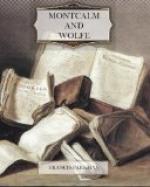The particulars of his burial are from the Acte Mortuaire du Marquis de Montcalm in the registers of the Church of Notre Dame de Quebec, and from that valuable chronicle, Les Ursulines de Quebec, composed by the Superior of the convent. A nun of the sisterhood, Mere Aimable Dube de Saint-Ignace, was, when a child, a witness of the scene, and preserved a vivid memory of it to the age of eighty-one.
Appendix K
Chapter 29. Sainte-Foy>
STRENGTH OF THE FRENCH AND ENGLISH AT THE BATTLE OF
STE-FOY
In the Public Record Office (America and West Indies, XCIX) are preserved the tabular returns of the garrison of Quebec for 1759, 1760, sent by Murray to the War Office. They show the exact condition of each regiment, in all ranks, for every month of the autumn, winter, and spring. The return made out on the 24th of April, four days before the battle, shows that the total number of rank and file, exclusive of non commissioned officers and drummers, was 6,808, of whom 2,612 were fit for duty in Quebec, and 654 at other places in Canada, that is, at Ste Foy, Old Lorette, and the other outposts. This gives a total of 3,266 rank and file fit for duty at or near Quebec, besides which there were between one hundred and two hundred artillerymen, and a company of rangers. This was Murray’s whole available force at the time. Of the rest of the 6,808 who appear in the return, 2,299 were invalids at Quebec, and 669 in New York, 538 were on service in Halifax and New York, and 36 were absent on furlough. These figures nearly answer to the condensed statement of Fraser, and confirm the various English statements of the numbers that took part in the battle; namely, 3,140 (Knox), 3,000 (John Johnson), 3,111, and elsewhere, in round numbers, 3,000 (Murray) Levis, with natural exaggeration, says 4,000. Three or four hundred were left in Quebec to guard the walls when the rest marched out.
I have been thus particular because a Canadian writer, Garneau, says “Murray sortit de la ville le 28 au matin a la tete de toute la garnison, dont les seules troupes de la ligne comptaient encore 7,714 combattants, non compris les officiers.” To prove this, he cites the pay-roll of the garrison, which, in fact, corresponds to the returns of the same date, if noncommissioned officers, drummers, and artillerymen are counted with the rank and file. But Garneau falls into a double error. He assumes, first, that there were no men on the sick list, and secondly, that there were none absent from Quebec, when in reality, as the returns show, considerably more than half were in one or the other of these categories. The pay-rolls were made out at the headquarters of each corps, and always included the entire number of men enlisted in it, whether sick or well, present or absent. On the same fallacious premises Garneau affirms that Wolfe, at the battle on the Plains of Abraham, had eight thousand soldiers, or a little less than double his actual force.




